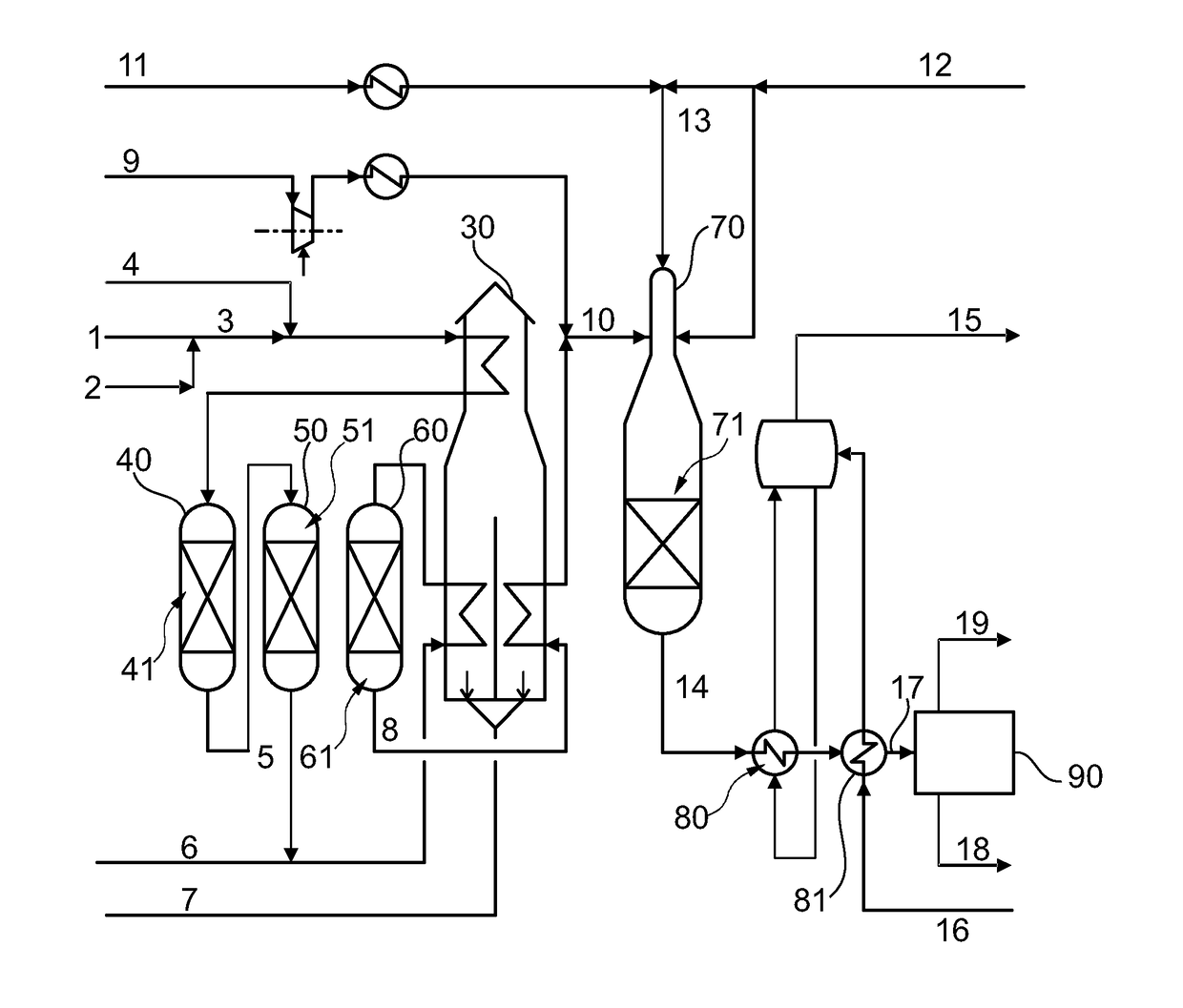Process for producing hydrocarbons
a hydrocarbon and process technology, applied in the field of hydrocarbon production process, can solve the problems of sulphur poisoning of pre-reformer catalysts, catalyst deactivation, and partial and expensive catalysts in the form of supported ruthenium, and achieve the effect of reducing equipment size, reducing process steam-to-carbon ratio, and reducing equipment siz
- Summary
- Abstract
- Description
- Claims
- Application Information
AI Technical Summary
Benefits of technology
Problems solved by technology
Method used
Image
Examples
example 1
[0083]In one embodiment a light-end fraction stream containing LPG components and other light gasses are withdrawn from separation step which could be a stripper column in the upgrading section. An example of light-end fraction stream composition is listed below:
[0084]
H229mole %CO4mol %CO211mole %CH46mol %N21mole %C23mole %C38mole %C418mole %C59mole %C6+6mole %H205mole %
[0085]A minor fraction of the hydrocarbons are olefins while the majority of the hydrocarbon fraction is paraffins. Further the stream could contain traces of sulphur components.
[0086]The light-end stream containing LPG is recycled to the desulphurization reactor of the syngas section in which it is mixed with a natural gas stream. The olefins in the combined gas stream are hydrogenated over a hydrogenation catalyst under the addition of hydrogen (typical CoMo og NiMo type catalyst) thereby removing undesirable olefins and any sulphur components in the combined gas are then removed on the desulphurization catalysts o...
example 2
[0088]In another embodiment the light-end gas from a separation step which could be a stripper column in the upgrading section has been further separated into a light end fuel gas and a LPG stream.
[0089]The LPG stream has the following composition:
[0090]
C20.7 mole %C3 28 mole %C4 70 mole %C5 1 mole %C60.3 mole %
[0091]A minor fraction of the hydrocarbons are olefins while the majority of the hydrocarbon fraction is paraffins.
[0092]The LPG stream is recycled to the desulphurization reactor of the syngas section in which it is mixed with the other hydrocarbon feed stream, namely natural gas. The olefins in the LPG stream are hydrogenated over the hydrogenation catalyst (typically CoMo og NiMo type catalyst). The LPG stream substitutes some of the natural gas coming (or other hydrocarbon feed stream coming from outside feed source). The hydrogenated and sulphur depleted feed gas is then mixed with steam and sent to the pre-reformer followed by the ATR reformer.
[0093]As an example from ...
example 3
Comparative
[0094]In another embodiment a light hydrocarbon fraction which is separated from the main hydrocarbon fraction in a separation step in a fractionation column. The main hydrocarbon fraction is a diesel fraction and the light end fraction is a naphtha fraction. The naphtha fraction is recycled to the syngas section and mixed with the other hydrocarbon feed upstream the desulphurization stage.
[0095]The naphtha stream contains long chain higher hydrocarbons and the syngas section must be operated at higher steam-to-carbon ratio to avoid carbon formation from the higher hydrocarbons in the reforming section and especially in the pre-reforming step. This will require a higher addition of high pressure steam to the hydrocarbon feed and thereby higher steam consumption. Most of the equipment will increase in size and thereby in cost due to the high steam-to-carbon molar ratios.
[0096]The naphtha stream is a stream with initial boiling point of 30° C. and final boiling point of 170...
PUM
| Property | Measurement | Unit |
|---|---|---|
| temperature | aaaaa | aaaaa |
| temperature | aaaaa | aaaaa |
| temperature | aaaaa | aaaaa |
Abstract
Description
Claims
Application Information
 Login to View More
Login to View More - R&D
- Intellectual Property
- Life Sciences
- Materials
- Tech Scout
- Unparalleled Data Quality
- Higher Quality Content
- 60% Fewer Hallucinations
Browse by: Latest US Patents, China's latest patents, Technical Efficacy Thesaurus, Application Domain, Technology Topic, Popular Technical Reports.
© 2025 PatSnap. All rights reserved.Legal|Privacy policy|Modern Slavery Act Transparency Statement|Sitemap|About US| Contact US: help@patsnap.com


